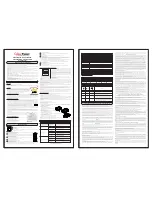
53
SALICRU
Turn the bypass switch/es of the panel to «On».
Turn the bypass switch
(Q4a)
of the UPS or each equipment
to «On».
•
Turn the output switch/es of the protection panel to «On».
•
Turn the output switch
(Q2)
of the UPS or each equipment to
«On».
•
The parallel equipments are set to Master or Slave, either bypass
or voltage, as they were in the last setting.
•
Wait till the static bypass is in operation. Visually, in the flow
diagram shown in the main screen, ,can be checked that the
energy flows through the static bypass.
•
Turn the manual bypass switch of the protection panel to «Off»
and put back the mechanical lock
(BL)
by fixing it with the
screw
(t
2
)
.
•
Turn the manual bypass switch
(Q5)
in the UPS or in each one
to «Off» and put back their respective mechanical lock
(BL)
by
fixing them with the screws
(t
2
)
.
•
For your safety, it is an essential requirement to put back
the mechanical lock/s
(BL)
, with the purpose of avoiding
wrong manoeuvring for the UPS and connected loads.
•
Start the inverter of the equipment/s up, to do it proceed as
follows:
Touch over the «Status and control» icon
Status & Control
.
Touch over the «Start/Stop UPS» icon
Start / Stop
UPS
.
The following «Pop up» message will be displayed, It asks to the
end-user if it he is sure about his selection
Are you sure ?
YES
NO
. Confirm
the action by touching over «YES».
•
After commissioning, the daily start up/shutdown oper-
ating of a single equipment or parallel system will be done
through the touch screen of the control panel
(PC)
. In parallel sys-
tems, it will only be needed to act over anyone of them.
Consider that the UPS or system will still be supplying
output voltage, regardless of the inverter/s status:
Shutdown, loads are supplied from static bypass.
Started up, loads are supplied from the inverter (On-line
mode).
Started up, loads are supplied from static bypass (Smart ECO
Mode).
•
After 30 seconds, the inverter and rectifier of the UPS or each
UPS will start up, and the output will supply the inverter/s
voltage.
•
For equipments with external battery cabinets, turn the fuse-
holder switch of the battery cabinet/s
(Q8)
of each UPS to «On».
DO NOT TRY to make this manoeuvring at any
other moment and/or in any other way, because it
could damage the equipment and/or cause accidents.
•
When the rectifier is in operation completely, an equalising pro-
cess will be started (the DC bus voltage will be equalised with
the battery voltage).
After a few seconds (depending on the level of the batteries),
the main menu will display the «Alarm» icon
in red colour
with the acoustic alarm triggered.
Touch over the «Alarm» icon
.
Check that in the alarm list, the message «Battery switch
opened: Close it» can be found.
Touch over the «Alarm acknowledgement» icon
to acknowledge it and silent it.
This alarm message means that the equalising process has been
finished and IN THIS MOMENT ONLY the battery switch or bat-
tery protection or both elements can be turned on:
Equipments with only one battery mechanism, either a
fuse-holder switch or battery switch and labelled in the il-
lustrations of this document as
(Q3)
. Turn it to «On».
Equipments with two battery mechanisms, fuse-holder
switch
(F3)
and isolator switch
(Q3)
.
1.
First, turn the battery fuse-holder switch
(F3)
to
«On».
2.
Next, turn the battery isolator switch
(Q3)
to «On».
In parallel systems, repeat the process for each equipment.
DO NOT TRY to make this manoeuvring at any
other moment and/or in any other way, because it
could damage the equipment and/or cause accidents.
In the main screen of the control panel of each equipment will
be displayed a flow diagram like the one in Fig 41.
The UPS or parallel system supplies voltage at its output, which
is protected against mains failures, blackouts, voltage fluctuations,
electrical noises, etc.
















































